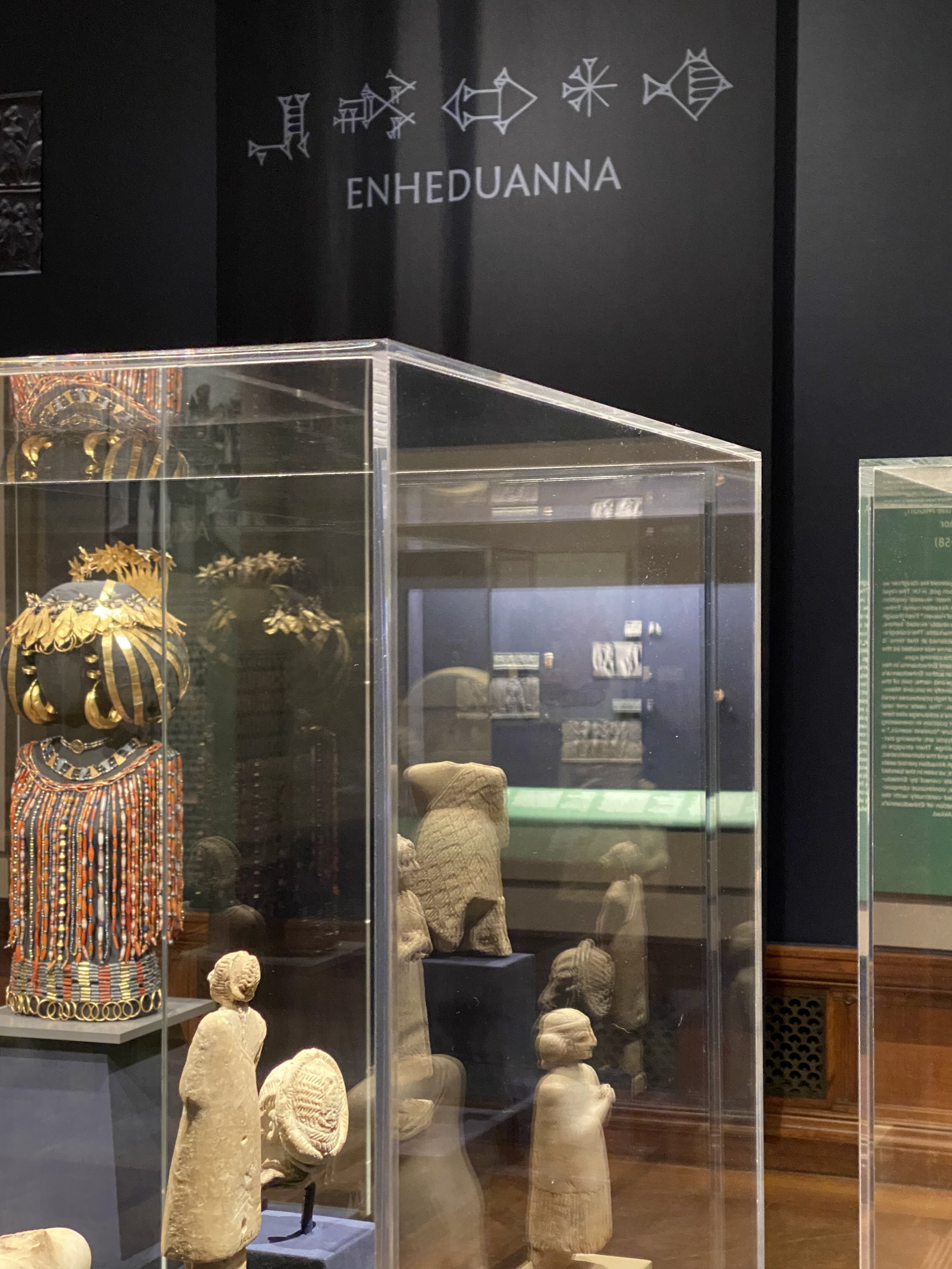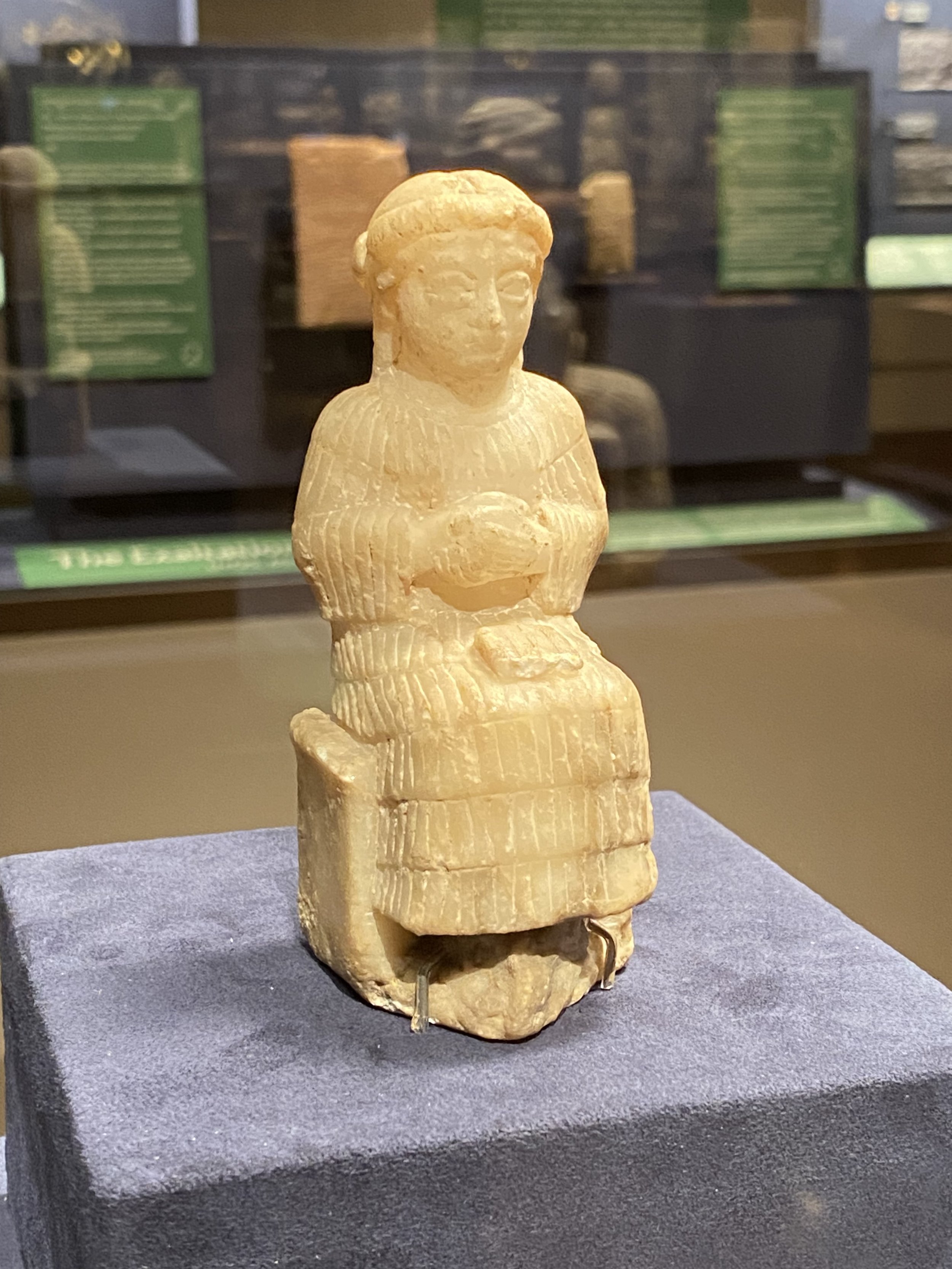She Who Wrote: Enheduanna
The exhibit She Who Wrote: Enheduanna and the Women of Mesopotamia ca. 3400-2000 B.C. at The Morgan Library in New York City was a work of art in and of itself. The curators, Sidney Babcock and Erhan Tamur, did a remarkable job telling the fascinating story of not only Enheduanna ca. 2300 B.C., the world’s first known author, but also the multifaceted women of ancient Mesopotamia. It is a colorful and captivating story with the exhibit acting as an impeccably lit stage, allowing the women to glow.
The women of Mesopotamia had varied and cultured lives. They shared in power, owned property, and managed large estates. The products and crafts made by their hands were often the economic drivers of Mesopotamia. The stories of these women have been buried under history and the tomes of scholarly study used to prop intellectual egos for far too long. While bringing these ancient women into the light, air is given to their voices, creating an exquisite experience.
I expected to see most of my favorite ancient works of art gathered in one room. I was not expecting to have that list rearranged and expanded extensively. I find the women of Mesopotamia endlessly fascinating. What captivates me may be the lack of exposure to the lives of women in that era, but it may also be that while women still held positions of prominence, those positions were tenuous and quickly degrading. Whatever the case may be, I was left dreaming of a future where everyone has access to this rich history of strong queens and priestesses and a time when hand woven textiles were as treasured and valuable as precious metals.
As I walked through the large wooden doors into the exhibition room, I caught my first glance of Queen Puabi’s headdress. It is stunning, but Queen Puabi herself is what I am truly drawn to. To quote Babcock, “She was a woman in her own right.” Of all the texts and works of art pertaining to her, none of them list her with or show her tied to any man. Not a husband, nor a brother, nor an uncle. She is Queen Puabi herself. She was a queen and she reigned.
Hours of scouring through archival photos and reading about Queen Puabi had not prepared me for how overwhelming it would feel to stand just inches away from her funerary attire. Seven gold flowers dangle from the hair comb tucked neatly behind her head, setting the tone for the rest of the headdress. Moving down, layered beading of lapis lazuli, carnelian, and agate intermix with leaves of gold expertly drawn to a point where a solitary carnelian bead is placed. Wide, golden ribbons wrap around what would have been expertly coiffed hair, while huge concave hoop earrings continue the gilded look. A cloak strung with hundreds of beads drapes her chest. With the expert lighting reflected off the metal, it is easy to imagine the queen attending a ritual and glistening under the full moon. The sound of the beaded cloak and the jingling metal would have been mesmerizing.
Many of the objects in the exhibit are shown “in the round”, set in a glass case where all sides are visible. Showing objects in this way is a powerful tool, used frequently by the curators to show multiple points of view, both literally and metaphorically. The center of the room is filled with figurines and statuettes displayed in this fashion. Every one of them is of a woman. They are of varying sizes, styles, and textures. Each has the unique features of the individual women they were made to represent. Most have the characteristically large eyes of Mesopotamian art, signaling to the deities that they are forever devoted. That message would have been of particular importance to the figurines that were used as votives and placed in the temple as surrogate worshipers. The temples were not congregational places for average citizens, as seen in many modern places of worship. They were home for the deity, a private place of residence where their needs could be attended to.
One of these figurines seen in the round is a kneeling woman made of smooth alabaster. Every angle of her beauty is easily observed. She is propped up on her feet with her now broken hands clasped at her breasts. Her hair flows long down her back with a circlet around her head signifying her probable status as high priestess. She has a delicately carved face using simple, graceful lines. Her serenity is infectious, and I continuously circled back to spend more time with her. Even now, weeks later, when life takes inevitable and sometimes unpleasant turns, I find myself thinking back to her. Her serene demeanor has become a touchstone.
When a curator has life-long expertise in an area, their exhibit is expected to reflect that. Babcock does not disappoint. In his daily life, he is the curator of an impressive collection of cylinder seals held by The Morgan Library. The seals are carved onto small stone beads in reverse relief with incredible detail. It is difficult to emulate the work, even with modern tools and techniques. The seals were then rolled in a continuous line on wet clay to identify and validate the information or contents held within. The seals needed to be intelligible to anyone, not just to the literate elite, therefore rather than using written language, scenes from daily life were often depicted. The functions of daily life were rarely, if ever, documented in the thousands of cuneiform tablets uncovered thus far, making the seals highly valuable sociologically.
One of my favorite seals being displayed, possibly for the first time, is the earliest image to provably be that of a priestess. She is receiving an offering and being attended to by two men in a temple. The seals chosen for this exhibit mostly involve women. Women are shown working together, performing rituals, seated on thrones, being attended to by men at banquets, dancing, performing in an all-girl band, supporting births, caring for children, and tending to livestock, amongst many other scenarios.
There are men in the exhibit, but the women are never shown subservient to them. The women are larger, carved deeper, and located physically higher. All are characteristics used to indicate prominence and importance. Women are not show as figurines solely being worshipped for fertility, relegated to objects of beauty, or as a mannequin quietly holding the son of God. They are Goddesses tearing down mountains, priestesses officiating ceremonies, and powerful independent rulers.
Religion and administration were inextricably mixed in Mesopotamia. Women were central figures in both aspects of society. A fact that has been unsurprisingly obscured or hidden throughout so many of the previous interpretations of this era. There is a four-sided stela – an upright stone slab – that is usually displayed with only one side visible. That side has an image of a priest that the stela is usually named for. On the side that’s usually obscured but was clearly displayed in the round in this exhibit, is the man’s daughter, Shara-igizi-Abzu. The stela was carved to commemorate the completion of a large land transfer, to her, making her the owner. She is carved larger and deeper into the stone than anyone else, clearly pointing to her significance in the scene, as well as in society. The curators have taken the bold step of naming the stela after her for this exhibition. I applaud this step.
Similarly displayed in the round is a stone tool used for scraping that is carved on both sides. The scraping blade is also usually displayed flat with only one side visible. Here it is shown upright and what is usually hidden from view is proudly displayed. It is a carving with a woman, that is mentioned by name. The first named woman in history: KA-GIR-gal.
Another small, alabaster figurine that pulls at my heart strings has long hair and a circlet designating her as a high priestess. This woman has a cuneiform tablet gently held in her lap. For numerous reasons, Babcock believes this to be a possible representation of Enheduanna herself. If it is Enheduanna or another unnamed priestess, it is clear evidence of a relationship between women and literacy. As a person frequently with book in hand, I easily see myself reflected in this ancient ancestor. The similarities are so striking I wonder what effect may have been had if I had been exposed to something similar in my younger years. How differently would I have envisioned women’s position throughout history?
Next to her are tablets inscribed with the “Exaltation of Inanna.” This poem was written by Enheduanna and copied for centuries in scribal schools venerating the goddess, Inanna. Her words are both an offering and a plea. Inanna is commonly known as the goddess of sex and war, but she was as multifaceted as the woman of ancient Mesopotamia and held many paradoxes. The tablets are surrounded by seals depicting Inanna as Ishtar, her later more warrior like form. Inanna is shown crushing mountains and subduing other gods in the pantheon. It is powerful to stand amongst these works with the strength of Enheduanna’s words living in my mind. I read over the English translations and pick through the tiny triangles of cuneiform. Some of the signs have become more familiar as I have studied the long dead language with the hope of reading the poem in one of its original forms. It feels like the veil is thinning between Enheduanna and I. We are separated by 5,000 years but drawn together through writing and love for a paradoxical Goddess with prehistoric roots.
This unique exhibition is hopefully the first of many similar in nature. It has become common knowledge that women’s stories, names, and entire selves have been erased from history for millennia. For women to be accurately represented in a historical perspective is still quite rare. This exhibit should be a scholarly call to arms for other historians. Do the hard thing. Make some of your colleagues uncomfortable. Show all the sides. It is time to bring balance and right the ship. Let the path forward be paved with more accurate perspectives, found by looking through new lenses and from different angles. Lift women up out of the historical margins and build them a stage.
Women at home, being subservient to men, while doing menial tasks is a story that is tired and should be put out of its misery. Let healing begin, as a full society. Women have not always been subjugated into servitude. Women were queens without kings. Women were authors. Women were skilled artisans. Women nursed gods and were caretakers of deities. Women were divine receptacles. Women cared for the dead, as well as the living. Women are the ancestor. Women are the mothers that brought every one of us here today. Thank you to Babcock and Tamur for your bravery in showing that there is more than one side of a work, for boldly renaming artifacts, and for sharing the lives of these women. One exhibit may not change the state of our current paradigm, but one never knows which straw will be the one that crumbles a decaying and dysfunctional system.







